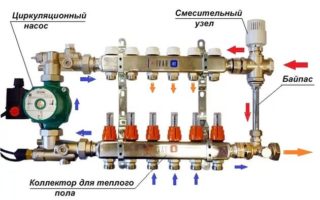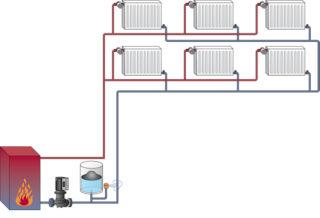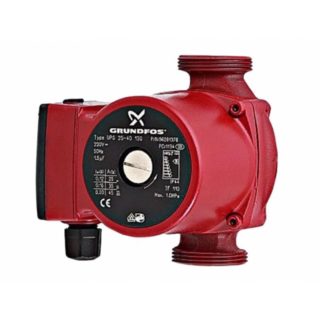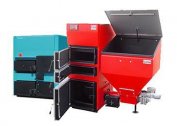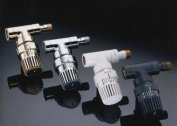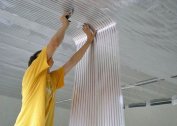In country houses and apartments with forced heating communications, heat unevenly enters the rooms. In order to increase the speed of the coolant, a circulation pump is used for heating. To choose the right device, you need to know the nuances of choice, design and design parameters.
Purpose of the circulation pump
The circular view of the pumps refers to devices operating in a closed-type heating system. It is necessary to move the coolant through the pipes and maintain the selected temperature. The device is intended for such purposes:
- achievement of design capacity of systems with forced circulation type
- increase energy efficiency of equipment;
- acceleration of the natural circulation process;
- performing the functions of pumping devices of a heat generator;
- adjustment of individual battery parameters in two-pipe systems;
- overcoming the inertia of autonomous communications with a natural type of circulation;
- closed fluid flow direction.
The pump does not compensate for the loss of coolant and does not provide filling of the line.
Design features
The pump used for the heating communications boiler looks like a drainage device. The design of the equipment is represented by a housing made of stainless steel, aluminum, cast iron and electrical elements in the form of a stator with a winding and an integrated rotor. The part is made of steel.
On the moving part of the engine (shaft) is a fixed impeller. The wheel consists of two parallel disks connected by radial blades. On one of the disks there is a hole where the coolant flows, and on the other there is a cavity that secures the impeller on the motor shaft.
The electric motor is made with a control board and terminals for connecting the cable. Non-electronics models are equipped with a capacitor and speed switch on the terminal box.
The principle of operation of the circulation pump
When using a circulation pump, the performance of domestic hot water systems and an autonomous heating main increases. Consider the operation of the unit by the example of the collector group of the warm floor:
- The flow of coolant into the inlet pipe.
- The supply of electricity and the transmission of torque from the rotor to the turbine wheel.
- Rotation, creating a vacuum in the pipe and forcing the coolant with the impeller.
- Moving water with inclined vanes at the time of torsion.
- The movement of water to the edge of the disk - a centrifugal type of force is activated.
- Water intake on one side and pushing in the heating communication in a constant mode.
- Pressure increase, overcoming resistance in different zones of the circuit.
The coolant will circulate until the pump stops.
Pump classification
The home view of communications or the heating of a multi-storey building allows the installation of units with various solutions of the “turbine-rotor” assembly.
Wet rotor models
The impeller and rotor are in constant contact with the working fluid. Water lubricates the elements of the device and at the same time cools it.The rotor and stator area is separated by a sealing vessel. The speed is set by a step regulator, which is convenient for controlling energy consumption.
Thanks to the modular design, repair and selection of parts to increase pressure is simplified. The engine with constant exposure to water does not require cooling. Modifications with a wet rotor have several advantages:
- minimum noise level;
- compactness and light weight;
- reduction in energy consumption;
- ease of setup and maintenance;
- long operational period.
The minus of the superchargers is the wear of the hydraulic mechanisms in the presence of small abrasive particles in the water.
Dry rotor devices for heating boilers
Pumps provide the transfer of large volumes of coolant in the absence of contact of the rotor and water. Housing made of cast iron or steel is coated with anticorrosive compounds. Between the motor and the pump unit there is a seal in the form of static and dynamic rings. The difference between dry rotor pumps is 85% efficiency.
For use in an apartment building, the following models are suitable:
- Monoblocks. The engine with the pump are located in one unit, which simplifies maintenance and operation.
- Cantilever. The axes of the motor and pump unit have a common line. The suction tube is located on the cochlea, the discharge tube is opposite it, on the body.
- In-line Installation is made on the pipeline. Suction and pressure nozzles are located in the same line. The seal compensation mechanism is automatic.
- Dual. They work together or separately. One unit is turned on when the second one breaks down - the boiler operates in a continuous mode.
Blowers with a dry rotor type are characterized by efficiency and maintainability. They are undemanding to the composition of the coolant.
Dry models make a lot of noise, so they need to be installed in a separate boiler room.
Pump selection for domestic hot water system
The recirculation pump is suitable for heating and solves the problems of supplying domestic hot water for household needs. To purchase a good device, you need to take into account:
- Noise at work. In residential areas, low-noise options are advisable.
- Heat transfer head at supply. With a horizontal hot water circuit, a column of water from 50 to 80 cm is required. A vertical circuit requires an indicator of 80 cm.
- Energy consumption. Depends on the power parameters.
You can install equipment for hot water supply in a classic heating circuit or in a warm water floor.
Device Specifications

Knowing the characteristics of the circulation pump will help you find the right option for home or apartment heating. When buying, the following parameters are taken into account:
- pressure - a technical parameter that determines the rise of water to a certain level;
- flow rate and performance indicator - the amount of coolant supplied for a certain time;
- mounting dimensions - the size of the device, allowing to determine the possibility of tapping into the pipeline.
On the front of the case there are digital and numerical markers:
- variety - circulation superchargers are designated as UP;
- speed adjustment - models with single-speed mode are not indexed, S means step switching, E - smooth frequency;
- the diameter of the inner pipe in mm;
- pressure - depending on the manufacturer, it is marked in meters or decimeters.
From the information on the front panel, you can determine the type of enclosure. N indicates that stainless steel was used, cast iron is not indexed, A - that there is a fitting for the vent, K - that it can be used for systems with cold water, KU - for cold, but with foam filler for the stator and terminal box.
Selection of a pump for a private house according to technical characteristics
The correct selection of pumping equipment is carried out on the basis of calculations according to several criteria.
Pressure
You will need to know the total length of the line for pumping water. For every 10 m of pipe length, you need 0.6 m of pressure. That is, a private home ownership with a heating circuit of 70 m provides a supercharger with a pressure of 4.2 m.
Power
Power calculation can be done on the basis of SNiP 2.04.07-86:
- for houses with a height of 2 floors - from 173 to 177 W / m2;
- for buildings of 3-4 floors - from 97 to 101 W / m2.
To select devices taking into account thermal insulation, wear of buildings, use the table.
| power, kWt | Room volume in new buildings, m3 | Room volume in old buildings |
| 5 | 70-150 | 60-110 |
| 10 | 150-320 | 130-220 |
| 20 | 320-600 | 240-440 |
| 30 | 650-1000 | 460-650 |
| 40 | 1050-1300 | 650-890 |
| 50 | 1350-1600 | 900-1100 |
Performance
To calculate performance, you need to apply the formula Q = 0.86R / TF – TRwhere:
- Q - flow rate per hour of coolant in cubic meters;
- R - thermal power spent on heating;
- TF - temperature indicator of water at the inlet;
- TR - temperature indicator at the return.
The coefficient of thermal power depends on the climatic conditions of the area. A private house in the European climate zone with a small quadrature provides for the cost of 100 kW for heating 1 square. In apartment buildings, 70 kW is spent per square meter.
Parameters
When calculating the external parameters of the pump, you will need to take into account the features of communications:
- on pipelines, mixers and floor-mounted bypasses, models are placed 18 cm in length;
- 13 cm long blowers are placed inside heat generators or a small main;
- the diameter of the nozzles depends on the cross section of the main pipe, you can increase the size;
- primary rings and boiler circuits, gravity pipes are suitable for variants with 32 mm diameter nozzles.
In stores, there are mainly bypasses for standard pumps 18 cm in length.
Overview of circulation pump models from popular manufacturers
Comparing injection devices is possible not only in terms of parameters. The choice also includes the study of information about models of well-known manufacturers.
Grundfos ups
High-quality device equipped with ceramic bearings, stainless sleeves and composite wheels. Grundofs produces mainly wet-rotor models, which differ:
- energy efficiency - consume 45-220 watts;
- minimum noise level not exceeding 43 dB;
- operating temperature range from 2 to 110 degrees;
- ease of installation and maintenance;
- compactness and light weight.
Grundfos equipment can not be called budget.
Wilo star-rs
A series differs in reliability of knots and electronic circuits. Wilo is an economical model with power control modes, a cast-iron case, polypropylene turbines. For shafts stainless steel is used, for bearings - metallographite. Features of units:
- ease of installation;
- work at a temperature from -10 to +110 degrees;
- the presence of a voltage protection system.
The pumps are noisy at high speed.
Dab va
Italian equipment should be selected for operation in domestic conditions. The engine is in a cast aluminum shell, the turbine ring is made of technopolymer, the shaft and bearing are made of ceramic. Features of devices:
- three speed adjustment modes;
- quick-release mounting clamps;
- installation dimensions 130 and 180 mm;
- noise level up to 70 dB.
The bushings are made of graphite.
Circulation pumps are mandatory if a closed heating circuit is installed in the house, beam distribution or a water floor is completed. Given the characteristics and features of the manufacturers' range, it is easy to find suitable equipment.


